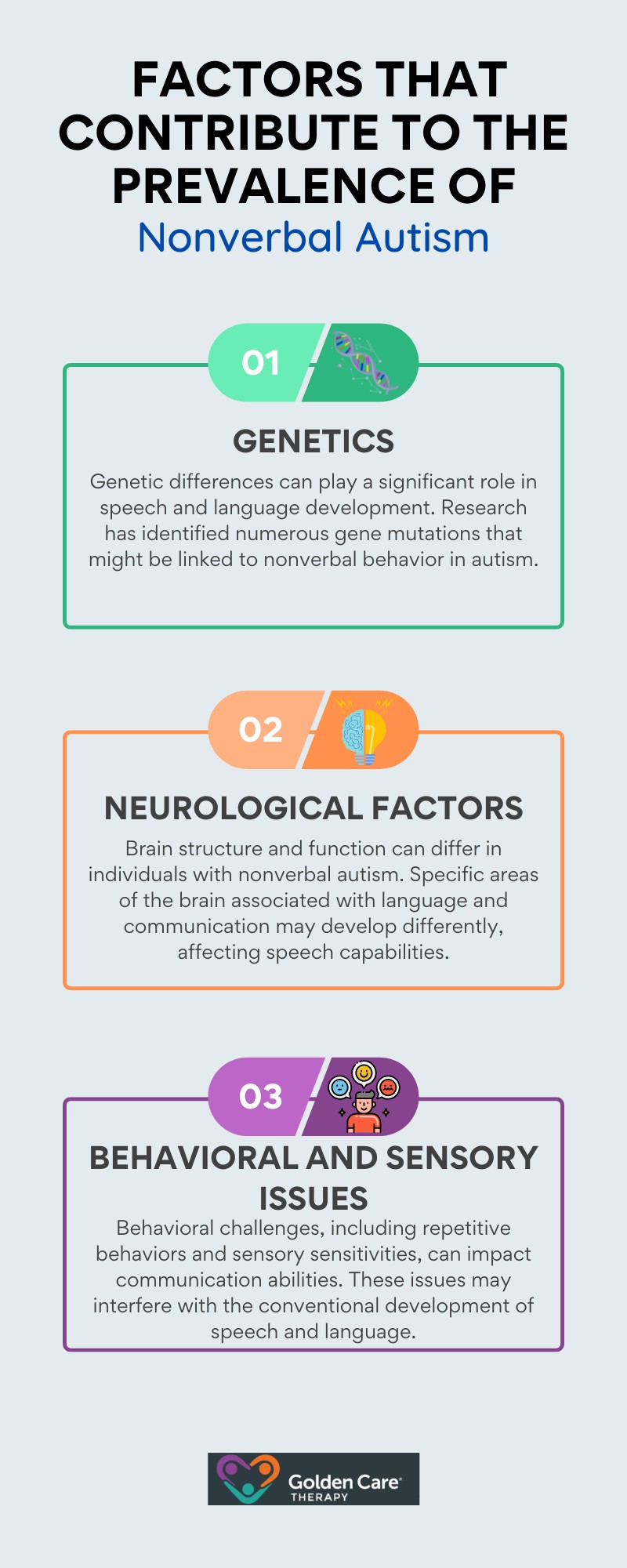Communication is one of the most powerful ways humans connect, but for some, the journey to finding their voice looks a little different. Among individuals with autism, the ability to use spoken language varies widely, with some relying on gestures, devices, or other forms of expression to share their thoughts. Available support and programs play a crucial role in helping individuals with autism develop effective communication skills, offering tailored strategies and tools to meet their unique needs.
This diversity leads to an important question: how many autistic individuals are nonverbal?
Understanding the answer not only highlights the unique challenges faced by this group but also celebrates the many ways communication can take shape.
What Percentage of Autism is Nonverbal?
Approximately 25-30% of autistic individuals are considered nonverbal, meaning they do not develop functional spoken language.
Nonverbal autism can vary widely in presentation; some individuals may not speak at all, while others might use limited words inconsistently or only in specific contexts. Instead of verbal speech, many nonverbal autistic individuals communicate through alternative methods like sign language, picture exchange systems, or assistive technology such as speech-generating devices.
It’s important to note that being nonverbal does not necessarily indicate an inability to understand language or express complex thoughts and emotions.
The percentage of nonverbal individuals can also depend on factors like age, access to early intervention, and co-occurring conditions. For example, some children initially classified as nonverbal may develop verbal communication skills later with the right support, though others may continue to rely on alternative communication methods.
Research emphasizes the need for tailored interventions that respect and build on each individual’s unique communication abilities, ensuring their voices are heard, even if not spoken.
Evolution of Diagnosis and Interventions for Nonverbal Autism
Over the years, the diagnosis of nonverbal autism has evolved significantly. Early diagnostic methods focused heavily on observable behaviors, often missing the communication difficulties faced by many children with autism.
As understanding of autism has grown, so has the focus on speech and communication skills in diagnostic criteria.
Researchers have rated standard assessments for use with minimally verbal children, identifying 18 assessments as well-suited and 25 that can be used with caution. This advancement in diagnostic tools has been crucial for early intervention.
Interventions have also evolved, with an increasing emphasis on tailored communication strategies. Randomized controlled trials of communication interventions for minimally verbal children have shown that both verbally based interventions and alternative and augmentative communication interventions can be effective.
These trials have explored methods such as the Picture Exchange Communication System (PECS) to help children develop functional communication skills.
Prevalence of Nonverbal Autism
Understanding the prevalence of nonverbal autism is crucial in comprehending the broader autism spectrum. Nonverbal or minimally verbal individuals with autism represent a significant subset of the autism community.
Based on recent studies and estimates, a substantial portion of individuals with autism exhibit nonverbal behavior or limited speech abilities.
According to research:
- Approximately 25% to 35% of people with autism have little functional speech.
- Around 25% to 30% of children diagnosed with autism either do not develop functional language or are minimally verbal, meaning they use fewer than 30 functional words or cannot use speech alone for communication.
- Estimates indicate that about 40% of individuals diagnosed with autism exhibit non-verbal autism.
Several factors contribute to the prevalence of nonverbal autism. These factors vary and can include aspects related to the following:

Understanding these statistics and factors is essential for parents, caregivers, and individuals with autism to better address and support the needs of nonverbal individuals within the autism spectrum.
Communication Interventions
Communication interventions for nonverbal autism can be categorized into two main types: verbal interventions and augmentative and alternative communication (AAC) interventions.
Verbal interventions aim to develop spoken language skills in nonverbal children with autism. The Focused Playtime Intervention (FPI) is an example of a verbally based intervention that concentrates on developing coordinated toy play between the child and parent.
This intervention consists of in-home training sessions over 12 weeks. The goal is to encourage expressive language development through play.
Meanwhile, AAC interventions use different forms of communication other than spoken language.
One widely researched AAC method is the Picture Exchange Communication System (PECS). PECS enables individuals to communicate using pictures and symbols. In a randomized controlled trial (RCT) with 84 minimally verbal participants, children who were not beyond phase 1 of PECS at baseline showed significant gains in using verbal initiations and PECS symbols immediately after the intervention.
However, these gains were not maintained 10 months later.
The effectiveness of communication interventions varies depending on the method used and individual differences among children. By understanding and leveraging different communication interventions, parents and caregivers can make informed decisions to support the communication needs of children with nonverbal autism.

Final Thoughts
Understanding the percentage of individuals with autism who are nonverbal offers valuable insight into the diverse ways autism can present itself. While numbers and statistics can guide awareness, they don’t define the potential, abilities, or individuality of those on the spectrum.
Every autistic person, whether verbal or nonverbal, has a unique way of expressing themselves, building connections, and contributing to the world.
Supporting communication in all its forms is a step toward creating a more inclusive and understanding society. At Golden Care Therapy, we take pride in offering high-quality ABA services in Indiana, New Jersey, New York, Georgia, and Florida.
Our experienced team is dedicated to providing personalized support that empowers individuals and their families. Contact us today to learn more about how we can help you achieve meaningful progress and lasting results.
Sources:



